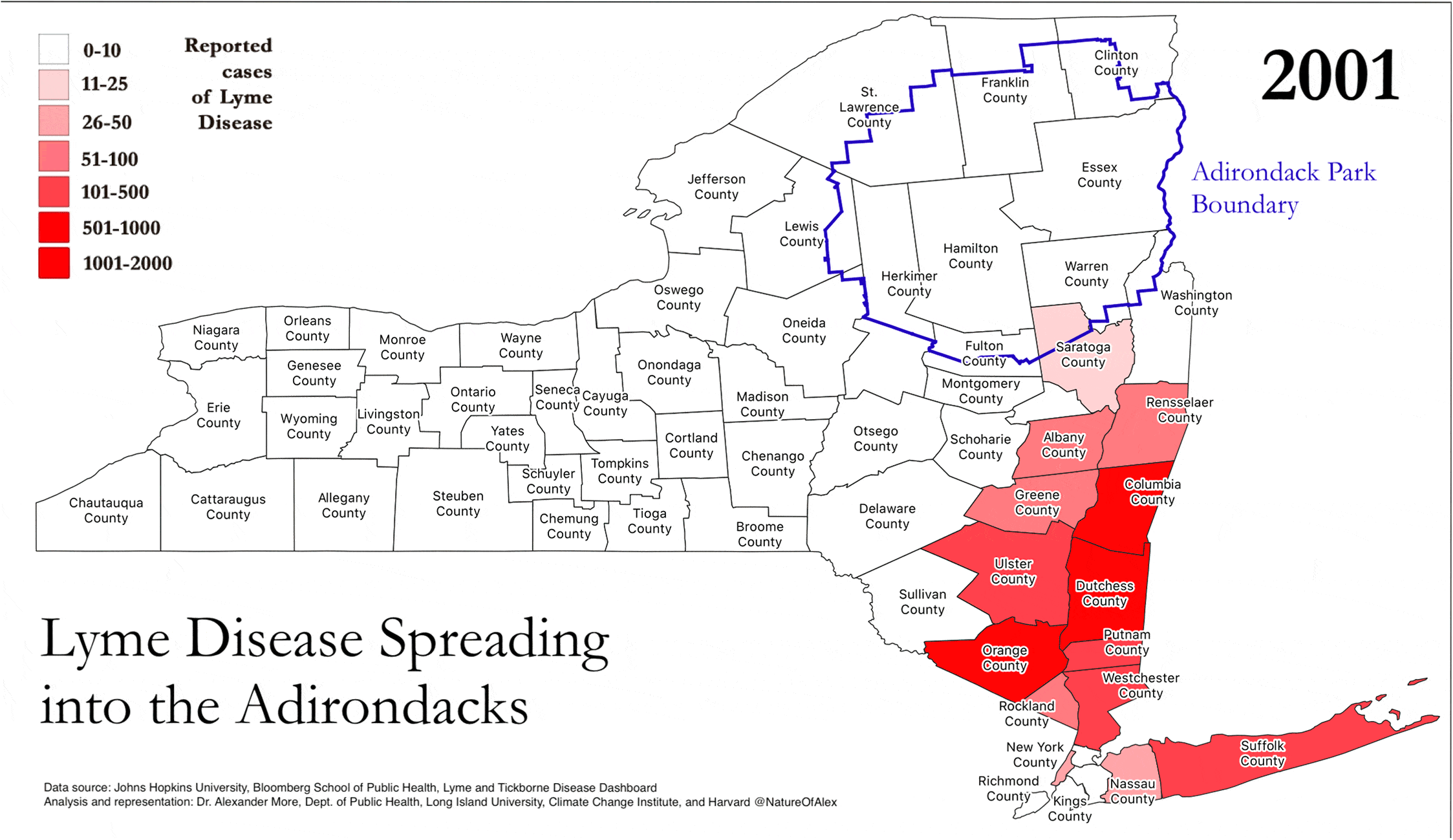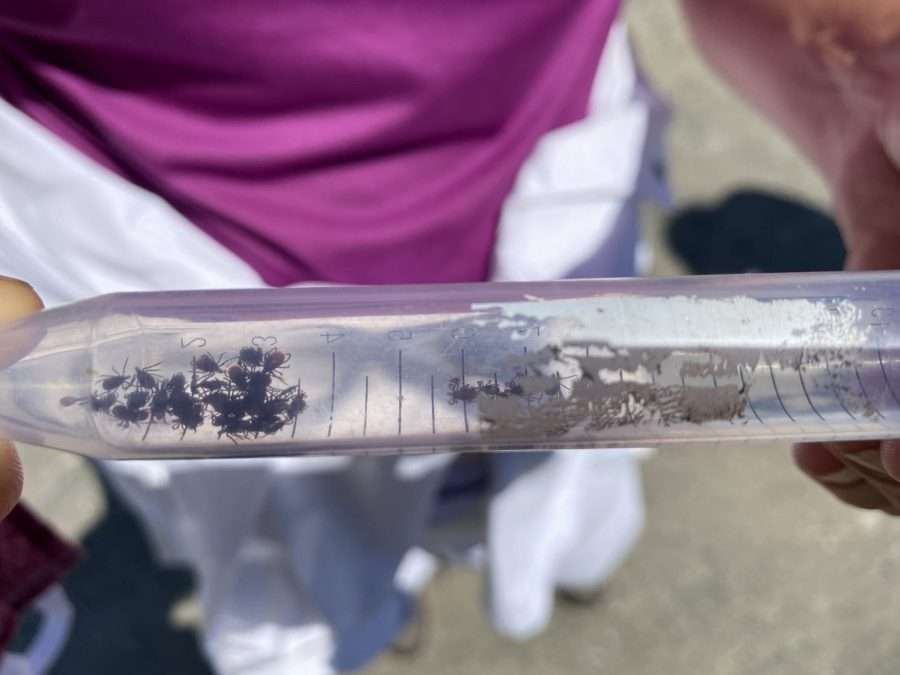
Researchers take note of northern spread of tick-borne illnesses
By Cayte Bosler
In the 1950s, physicians urged parents to not allow their children to venture into areas known to be infested with wood ticks. After a day in the country, a child might turn up to the dinner table “with unaccountable black specks” because “ticks [were] out in unusually strong numbers in the tall grasses” of Long Island, reported the New York Times in 1953. Then, the worry was that ticks could transmit Tularemia or “rabbit fever,” caused by the bacterium Francisella tularensis.
Now, anyone who ventures into the woods risks the newer and varied dangers posed by these black specks. The black-legged tick, Ixodes scapularis, also known as the deer tick, transmits up to seven different diseases, many of those on the rise, as the tiny arachnids creep farther into areas they previously were not. Scientists attribute this in part to climate change.
Tick-borne diseases already account for more than 75% of reported vector-borne diseases in the US, according to the Centers for Disease Control and Prevention.
“The overall warmer and wetter conditions brought by climate change probably favor tick survival and an increase in their populations. They have a better chance of surviving the winters because they are milder.”
— Lee Ann Sporn, Paul Smith’s College professor
Winters used to keep them at bay, but this isn’t the case anymore. In the United States, 2021 was the fourth hottest year on record with winter as the fastest-warming season, especially in northern locations and higher altitudes.
“Most of their life, ticks are dormant, but there are more days in the year where it’s suitable for them to quest,” Sporn said. Questing is when ticks seek to attach themselves to a host, be it a small mammal or bird, a deer, dog or a person who brushes past. “They will only quest when the conditions are right, which usually means humid,” he said “Climate change makes more days like that possible throughout the year.”

These new studies from Paul Smith’s college build on previous, decades-long observations of tick ranges and the associated tick-borne illnesses. In 1984, scientists told the Times that ticks had been found on a wide variety of Connecticut birds thought to be distributing them out of the state, where Lyme disease was first documented in 1976. Cases were appearing for the first time on Long Island and in the Hudson Valley, leading the scientists to believe that the flighted animals were responsible for their arrival.
In the last two decades, Lyme cases in the U.S. have tripled, the CDC reported. According to the New York State Department of Health, the state has the highest number of reported and confirmed cases in the country.
The Environmental Protection Agency acknowledges the rise of Lyme disease as a clear indicator of climate change. In a recent report, the Intergovernmental Panel on Climate Change specified the northern expansion of tick-borne illnesses in the U.S. as an important vector to continue to monitor because of its profound impact on human health. Lyme disease is viewed as a harbinger of the prediction that more infectious diseases could proliferate with changing climatic conditions.
In addition to Lyme disease, state public health officials warn of anaplasmosis, from the bacterium Anaplasma phagocytophilum, which mimics many symptoms of COVID-19, such as fever, difficulty breathing and headaches. Anaplasmosis statewide quadrupled from 2010 to 2018, with more than an eightfold increase in the Albany region, according to a new study published in the journal Emerging Infectious Diseases. Although the disease can be fatal, it’s easily treatable if detected early and cannot be spread from person to person. Building in the public awareness of its prevalence is a priority.
RELATED COMMENTARY: Consider adding this ingredient to your tick defensive strategy READ MORE IN THE ADIRONDACK ALMANACK
“It’s got to become more of the culture that, yes, we have ticks.” Sporn said. “Especially in northern New York where ticks are emerging. Infection rates to humans in the North Country are high and steadily increasing. We need to warn people that they are around.”
Many New York state parks feature a “Prevent Tick Bites!” sign at trailheads to educate the public, but places where ticks historically weren’t present need additional outreach to ensure they’re prepared.
“If we can predict where the ticks are moving because of climate change we can inform health care providers to ‘think tick-borne diseases’ when making a diagnosis.”
– Lee Ann Sporn
Sporn is working with her students to continue monitoring the surveillance of ticks and the diseases they carry to document any spread. Paul Smith’s College continues to partner with government health offices for outreach to the public.
“It’s about consistent, responsible messaging when it comes to educating the public on new risks from tick-borne diseases exacerbating climate change,” Sporn said.
Historically, public officials and scientists advocated for a spectrum of mitigation measures running the gamut from imperfect and ineffective solutions, like issuing deer reduction hunts, to more effective biocontrols like the introduction of wasps, a natural tick enemy, to the adoption of the pesticide DDT recognized after its widespread use to cause catastrophic rippling ecological problems.
Sporn said the use of vaccine-laced pellets aimed at the small mammals in an ecosystem that have proven to be successful in previous trials. Vaccinating the tick-hosts against disease could significantly reduce the risk of initial infection spilling into the arachnid population which then can infect humans. The problem of scaling up this solution is stuck at the cost to manufacture the product and a concerted effort to adopt it as a strategy. The vaccine is tailored for mice, and yet to be proven effective in other Lyme-carrying animals like chipmunks and birds. A vaccine for humans, LYMERix, was available, but was discontinued in 2002 due to lack of demand.
Taking the advice of the physicians in the 1950s and not venturing into areas known to have ticks in New York would be nearly impossible now. But establishing a habit of tick checks after every outing could help to decrease significantly the risk of infection to humans (the tick needs to be present on the skin for 36-48 hours before a person can become infected). Research suggests this could spare one from showing up to the dinner table with black specks.
More to Explore
Subscribe to print/digital issues of Adirondack Explorer,
delivered 7 times a year to your mailbox and/or inbox
"explorer" - Google News
March 25, 2022 at 04:12PM
https://ift.tt/D5AG4sp
As winters warm, ticks thrive - Adirondack Explorer
"explorer" - Google News
https://ift.tt/wL8mW3q
Bagikan Berita Ini














0 Response to "As winters warm, ticks thrive - Adirondack Explorer"
Post a Comment